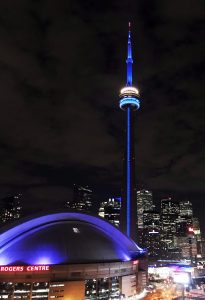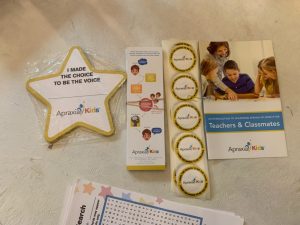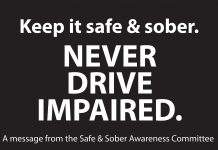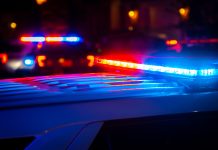
Landmarks from coast to coast, including the Bracebridge Falls, will be lit up blue on May 14 in an attempt to raise awareness for a rare neurological disorder known as apraxia.
Childhood apraxia of speech (CAS) is a motor speech disorder. Children with apraxia typically have a good understanding of language and know what they want to say, but they struggle to learn and perform the specific movements required to speak clearly. Brooke Rea is a speech-language pathologist with a concentration in CAS and works with children in communities across Ontario, Muskoka included. She is the owner and director of the Childhood Apraxia & Speech Therapy Centre in Guelph.
“An incredible amount of regular and ongoing speech therapy is required for these children to learn how to verbally communicate,” Rea said. “Generally kids with apraxia are cognitively intact and understand and have good social skills, it’s just that they can’t communicate outwards.”
Rea sits on the professional advisory council for Apraxia Kids, a nonprofit created to support children with apraxia and their families. Apraxia Kids first launched in the United States, but with the help of professionals like Rea, the organization is working to create a Canadian branch. Apraxia Kids Canada is now a registered nonprofit and they’re working toward full charitable status.
As the Canadian branch continues to grow, Apraxia Kids will continue to offer support and resources to families in Canada through annual walks, conferences and their iPad program, which provides tablets for use as a communication tool. The support is crucial because apraxia is lifelong, Rea said, along with being largely unknown.
“It’s definitely still a disorder that, unless you know someone with it, or have experienced it in your immediate family, you don’t know about it,” she said. “Most families hear it for the first time when their child is diagnosed.”
Speech language pathologists (SLPs) that want to work in apraxia have to seek out postgraduate training on the topic, but it’s becoming increasingly accessible. Throughout the pandemic, more online training has become available, so SLPs can take coursework to improve their training at any time.

Last summer, Apraxia Kids hosted an intensive five-day training boot camp for Canadian and American SLPs. Because it was virtual, it allowed the organization to train a large number of professionals across Canada for the first time, Rea said, so they plan to hold a similar event in 2023. Though COVID has improved access to apraxia education, it’s made it even harder for families to access treatment.
The lack of overall awareness for apraxia often translates to difficulty for families trying to access funding and treatment, and with recent cuts in the public sector, it’s only gotten worse. There are fewer treatment sessions available, Rea said, and families are having to spend more and more money on private therapy. The shift to virtual appointments during the pandemic also presented issues, with many children not responding to the online format.
“Having to make that shift as professionals, especially for the first part of the pandemic, really limited us in making gains with our small younger children,” Rea said. “Doing that virtual therapy has just been a real challenge and so the children have certainly lost precious therapy time.”
Early intervention is an important part of apraxia treatment, so losing that therapy time can be a major setback. For people who want to help improve the situation, there are many ways to get involved, including volunteer opportunities with annual awareness walks as well as chances to fundraise in support of Apraxia Kids’ programming. People can also raise awareness by encouraging schools and municipalities to recognize apraxia on May 14 by wearing blue shirts and lighting up landmarks.
Bracebridge resident Jody Hamilton has been a staunch advocate for apraxia ever since her son Nash was diagnosed three and half years ago. On top of promoting awareness in Muskoka and advocating for her son, she acts as a moderator for the Apraxia Kids Canada Facebook group and works to raise awareness across social media.
“I just keep finding more ways to make awareness for it because the more people that are aware, the more people include him and understand him and understand that his voice is a little different than most children,” Jody said.

Local awareness for CAS grows each year that the Bracebridge falls are lit up blue, she said. Some families have discovered that their children could have apraxia while others have discovered a network of like minded people to connect with.
Jody has made many friends through awareness events and media coverage, giving her other parents that understand her struggles and giving Nash friends who also have apraxia. He has a special connection with other children with apraxia where they seem to understand each other even without words, Jody said.
Nash is now six years old and has made major progress in treatment, especially in the last year. Now that he’s old enough to attend school, Nash lost some of his funding since it’s no longer considered early intervention, but he’s continued to improve regardless. He has speech therapy three times a week and has an educational assistant that works with him on his speech for about 20 minutes each day at school.
“I wouldn’t change it for the world, but his life, it’s going to be very different than a child that doesn’t have it,” Jody said. “He’s just going to have to work that much harder, which is fine, and Nash is amazing like that, so it’s great that he’s already starting to advocate for himself.”
Jody was nervous about Nash starting senior kindergarten, but his school has been great and Nash has made major strides. He had between 100 and 200 words he could say clearly at this time last year, but now, he has over 1,000 words, Jody said. There was a time where she didn’t know if he’d speak in more than three-word sentences, but he currently averages about six to eight words.

Not everything he says can be fully understood by everyone, so he uses an augmentative and alternative communication (AAC) device as well as sign language to help clarify. Jody continually teaches him that it’s okay to be different and that there’s many ways to be different, whether it’s based on ability, culture or a variety of other factors. The first week of class, his teacher was talking about what makes a person special and Nash raised his hand to say that for him, it’s apraxia.
Jody ordered a resource package from Apraxia Kids with bookmarks, stickers and colouring pages that explain apraxia and how to talk with people who have it, aiming to help Nash’s classmates understand his experience. She won’t always be there to advocate for him, so she wants people to know that the most important thing when interacting with someone who has apraxia is to simply give them time to communicate.
“They’re little shining stars,” Jody said. “They’re just trying to get their voice.”







